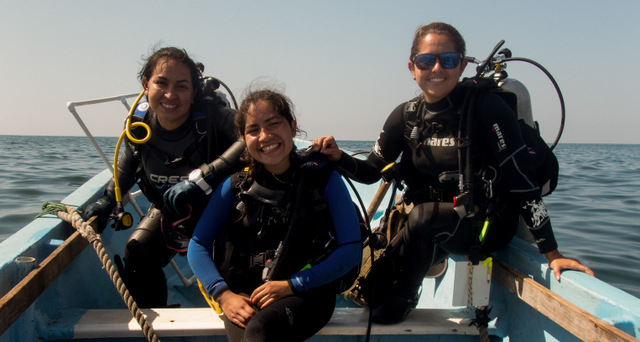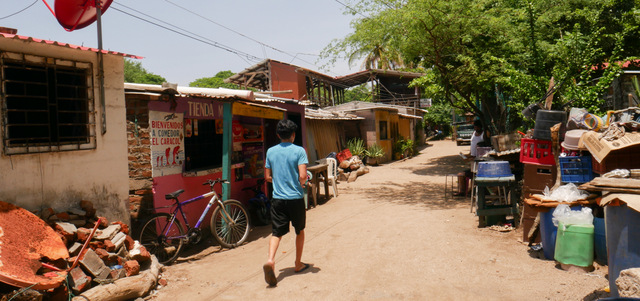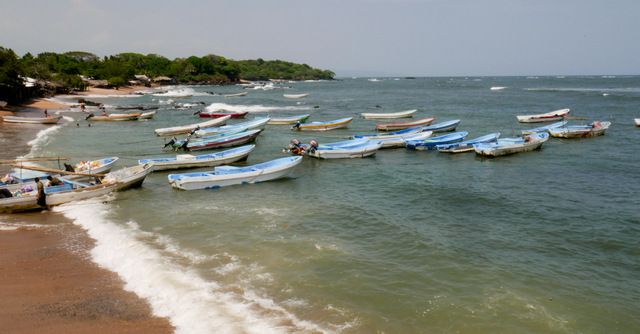LOS CÓBANOS, El Salvador – The fisherman Luis Morán walked towards his small boat, which floated in the water a few meters from the shore of the beach, on the Salvadoran coast, and as he advanced, he said: how could they not damage the coral reefs with this sea so hot?
Morán lives on the edge of Punta Remedios beach, on the edge of the 22-hectare Los Cóbanos Complex Protected Natural Area, a marine reserve located in the western department of Sonsonate, in El Salvador.
It is a site recognized for being the habitat of the only rocky reef with coral growth in this country of the Central American isthmus with coasts only towards the Pacific Ocean.
Los Cóbanos is also a hamlet belonging to the Punta Remedios canton, within the municipality of Acajutla, with its capital of the same name, and about 90 kilometers west of San Salvador. This village is located within a coastal area where poor communities mainly dedicated to fishing live.
From talking so much about coral reefs with and collaborating with marine biologists who work in the area, Morán has learned that the warm water temperature affects them negatively.
“This water is so hot that it already looks like soup,” the 56-year-old fisherman told IPS, aware that impacting these organisms is also affecting the fishermen’s livelihoods.
Many of the fish species that have commercial value to the community, such as the red snapper, are protected and reproduced on the reefs.
Other fishermen from Los Cóbanos with whom IPS spoke confirmed that fishing is increasingly scarce in the area.
Melvin Orellana, 41, said he went out to sea a few days ago hoping it would do well, but only caught less than 2.5 kilograms of fish.
“I didn’t even get the gasoline,” said this father of two.
Orellana uses nine gasoline cans, each containing 18 gallons (about 68 liters), to power its 75-horsepower engine. The gallon (almost four liters) costs the equivalent of about four dollars.
He and the other fishermen go out to sea, up to 70 nautical miles (130 kilometers), to search for shark, dorado and snapper.
Coral reefs at risk of perishing
The warming of the sea temperature, produced by climate change and expressed, for example, in the El Niño phenomenon, is one of the factors, among others, that is damaging coral reefs around the world, and Los Cóbanos does not it is the exception, said biologists interviewed by IPS.

This heating produces the so-called “bleaching” of the corals, colonial animal organisms that live in association with microalgae, which provide food through photosynthesis but which the corals end up expelling when they feel stressed by the increase in water temperature. By losing them, they become white.
That is a sign that they are being impacted, they are not dead, but they could die if they remain in that warm temperature for a long time, marine biologist Johanna Segovia explained to IPS.
“If they stay at that temperature for three months, it begins to die … but if the temperature is restored, it can recover again,” added Segovia, a researcher at the Francisco Gavidia University of El Salvador.
The impact is already evident, and biologists have already confirmed it.
“We have gone from having three percent coverage (coral), to only one percent”, in the Los Cóbanos natural reserve, Segovia stressed after diving among the reefs off the coast, which he usually does as part of his research. about the ecosystem.
Currently, the living coral cover observed in the area belongs to the species Porites lobata.

A report from the United Nations Environment Program (UNEP), already warned in a 2019 report that by 2050, 70% to 90% of the coral reefs in the world will be lost, even if actions are promoted at the level. to stabilize global warming at 1.5 degrees Celsius, above pre-industrial levels.
This heating of the water is what also leads the fish to move away from the coast, to compensate for the difference in temperature, as they are not able to regulate it by themselves.
In addition to the phenomena associated with climate change, these organisms are being hit by the actions of industrial fishing and local communities.
For example, the mismanagement of river basins, upland, causes pollution and sediment to reach the reef ecosystem.
Agriculture, with extensive use of pesticides, and deforestation, affect the river basins, upland, whose waters carry pollution and sediment to the coral reef area.
“Coral reefs are fragile ecosystems, and some environmental variables of the ocean, such as the temperature and sedimentation that reach them, are factors that greatly affect their deterioration,” Professor Francisco Chicas, from the School of Biology of the University of El Salvador.
Unsustainable tourism is another cause of this deterioration.

This flow of visitors tends to disrespect local regulations that prohibit affecting the coral ecosystem in any way.
Tourists can get close to the species that are almost on the surface, but it is forbidden to touch them, much less try to take them away.
It is even forbidden to take biogenic sand, which is yellow in color, and which is actually the remains of decomposed shells and corals.
In Punta Remedios they have organized to ensure that none of this happens.
“On Sundays my son-in-law seizes the bottles with sand and crabs,” said Morán, with four adult children and who, together with his wife, María Ángela Cortés, runs a mini restaurant located on a wooden platform that overlooks to the sea, with a menu focused on its products.
He complained that tourists leave their garbage scattered anywhere.
For this reason, José Cruz Miranda, also a resident of the canton, is dedicated to collecting cans of carbonated drinks and beers. In his house he has about 30 kilograms stored, in total. Each kilo is sold for 0.80 cents to a recycling company in Ajacutla.
Miranda suffers from diabetes, and with the money from the cans she has been buying the medicine to alleviate her ailment.
“That helps me cope with the problem of diabetes,” he told IPS.

Central American similarities
The factors that are impacting the reefs in Los Cóbanos are also affecting the rest of the Central American area.
In Costa Rica, coral reefs “are losing their health due to all anthropogenic and natural factors, of course all this is exacerbating climate change,” the environmentalist, co-founder of the non-governmental Raising Coral Costa Rica, told IPS. , Tatiana Villalobos.
That country has a coral coverage of about 970 square kilometers, which includes both the Pacific and Atlantic coasts, although Villalobos warned that the figure dates from about 10 years ago.
There are areas, he said, where reefs recover better than others.
An example in the Costa Rican Pacific is the Isla de Coco, located about 535 kilometers southeast of the coast. There the situation has been controlled and it can be said that the reefs are in good health.
It is on the coast, Villalobos said, where there has been a significant loss of coral cover, due to sedimentation, pollution and in general due to bad environmental practices.
Overfishing is also a problem, as it is in the rest of the Central American area and the world.
It happens when herbivorous species are fished and this causes changes in the ecosystem that end up impacting the reef.
Overfishing in Los Cóbanos, for example, is a serious problem, especially because although local fishermen fish with “hand line”, those who arrive from other areas do so with nets, despite the fact that it is prohibited.
In Honduras, the situation is quite similar.
Gisselle Brady, program coordinator for the non-governmental Ecological Association for the Conservation of the Bay Islands (BICA), told IPS that, although the ecosystems and culture in this area of the Honduran Caribbean are different from those of the Pacific coast, the problems are basically the same.
Among them, he mentioned overfishing, climate change, unsustainable tourism, and the lack of regulation by the State to keep these ecosystems healthy.
On the contrary, Brady added that the Honduran government is promoting, with a law approved in 2018, further advancement of the tourism sector, as well as with the controversial industrial parks called Zonas de Empleo y Desarrollo Económico (Zedes), which do not adhere to national laws.
That is impacting even natural reserves where corals are present, such as in the Nombre de Dios park, in La Ceiba, in northern Honduras, Brady said.
“It is sad that national laws are promoting this unsustainable development,” said the expert from the island of Roatán, the largest in the department of the Bay Islands.
He noted that a measurement used in the so-called Mesoamerican Reef, which covers the Caribbean coasts of Mexico, Belize, Guatemala and Honduras, gives a score of five when the reef is healthy.
Honduras has gone from three, considered fair, to 2.5, which is poor. Danger stalks its reefs. And you are not alone.
ED: EG
–

